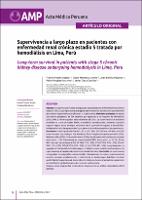| dc.contributor.author | Pinares-Astete, Franck | |
| dc.contributor.author | Meneses-Liendo, Víctor | |
| dc.contributor.author | Bonilla-Palacios, Juan | |
| dc.contributor.author | Ángeles-Tacchino, Pablo | |
| dc.contributor.author | Cieza-Zevallos, Javier | |
| dc.date.accessioned | 2019-04-11T16:31:03Z | |
| dc.date.available | 2019-04-11T16:31:03Z | |
| dc.date.issued | 2018 | |
| dc.identifier.citation | Acta Médica Peruana. 2018;35(1). | es_PE |
| dc.identifier.uri | https://hdl.handle.net/20.500.12959/248 | |
| dc.description.abstract | Objetivo: Evaluar la supervivencia a largo plazo de pacientes con enfermedad renal crónica
estadio 5 (ERC-5) que ingresaron a un programa de hemodiálisis en Lima, Perú y se determinó
las variables de pronóstico que afectaron la supervivencia. Materiales y métodos: Se evaluó
una cohorte prospectiva de 604 pacientes que ingresaron a un programa de hemodiálisis
(1982-2009) y fueron seguidos hasta diciembre del 2015. La supervivencia fue estudiada
mediante las curvas de Kaplan Meier; se estableció comparaciones, utilizando la prueba
Log-rank según: edad, etiología, trasplante renal y período de ingreso a hemodiálisis.
Mediante el análisis de regresión de Cox, se determinó variables pronósticas de supervivencia.
Resultados: La edad promedio fue de 51,95 ± 16,17 años. El 43,1% era ≥ 60 años; el 43,4%
fueron mujeres. Las etiologías más frecuentes fueron las glomerulopatías primarias (21%),
diabetes mellitus (20%), hipertensión arterial (12%) y las nefropatías intersticiales y/o uropatías
obstructivas (11%). El porcentaje de supervivencia (IC95%) en los años 1, 5, 10, 15 y 20 fue
80% (intervalo de confianza al 95% [IC 95%]: 77% - 83%), 47% (IC 95%: 43% - 51%), 25% (IC
95%: 21% a 29%); 17% (IC 95%: 13% - 21%) y 11% (IC 955: 8% - 14%), respectivamente. La
regresión de Cox identificó al adulto mayor y al diabético como variables desfavorables en la
supervivencia y al trasplantado renal como variable favorable. Conclusión: La supervivencia
a largo plazo es comparable a otros estudios internacionales. La menor supervivencia de
nuestros pacientes se relacionó con la condición de ser adulto mayor, diabético y no tener
posibilidad de trasplante renal. Los cambios tecnológicos durante el período de seguimiento
no modificaron significativamente las curvas de supervivencia. | es_PE |
| dc.description.abstract | Objective: To assess the long-term survival of patients with stage V chronic kidney disease that entered a hemodialysis
program in Lima, Peru and prognostic variables that affected survival were determined. Materials and methods: We
assessed a prospective cohort of 604 patients enrolled in a hemodialysis program (1982-2009) and who were followed-up
until December 2015. Survival was studied using the Kaplan Meier curves and comparisons were established using the
Log-rank test; according to age, etiology, renal transplantation and period of admission to hemodialysis. Through the Cox
regression analysis, prognostic variables of survival were delimited. Results: The mean age ± SD age of the population
was 51.95 ± 16.17 years; 43.1% were > 60 years old, and 43.4% were women. The most frequent etiologies were primary
glomerulopathy (21%), diabetes mellitus (20%), high blood pressure (12%), and interstitial nephropathy and/or urinary
tract obstruction (11%). Survival percentages (95% confidence interval) in years 1, 5, 10, 15, and 20 were 80% (77%-83%);
47% (43%-51%); 25% (21%-29%); 17% (13%-21%), and 11% (8%-14%), respectively. Cox regression analysis identified
being elderly and diabetic as unfavorable variables for survival, and having undergone renal transplantation as a favorable
variable. Conclusions: Long-term survival is comparable to that found in other studies performed abroad. The lower survival
of our patients is related to the following conditions: advanced age, diabetes, and not having the possibility of undergoing
renal transplantation. Technological changes during the follow-up period did not significantly modify the survival curves. | |
| dc.format | application/pdf | es_PE |
| dc.language.iso | spa | es_PE |
| dc.publisher | Colegio Médico del Perú | es_PE |
| dc.relation.uri | https://amp.cmp.org.pe/index.php/AMP/article/view/436 | |
| dc.rights | info:eu-repo/semantics/openAccess | es_PE |
| dc.rights.uri | https://creativecommons.org/licenses/by-nc-nd/4.0/ | es_PE |
| dc.source | Seguro Social de Salud (EsSalud) | es_PE |
| dc.source | Repositorio Institucional EsSalud | es_PE |
| dc.subject | Nefrología | es_PE |
| dc.subject | Insuficiencia Renal Crónica | es_PE |
| dc.subject | Supervivencia | es_PE |
| dc.subject | Diálisis Renal | es_PE |
| dc.subject | Enfermedad renal crónica | |
| dc.subject | Supervivencia en diálisis | |
| dc.subject | Hemodiálisis | |
| dc.subject | End-stage renal diseases | |
| dc.subject | Survival on dialysis | |
| dc.subject | Hemodialysis | |
| dc.title | Supervivencia a largo plazo en pacientes con enfermedad renal crónica estadio 5 tratada por hemodiálisis en Lima, Perú | es_PE |
| dc.title.alternative | Long-term survival in patients with stage 5 chronic
kidney disease undergoing hemodialysis in Lima, Peru | |
| dc.type | info:eu-repo/semantics/article | es_PE |
| dc.subject.ocde | https://purl.org/pe-repo/ocde/ford#3.05.00 | es_PE |
| dc.publisher.country | PE | es_PE |
| dc.identifier.doi | https://doi.org/10.35663/amp.2018.351.436 | |









